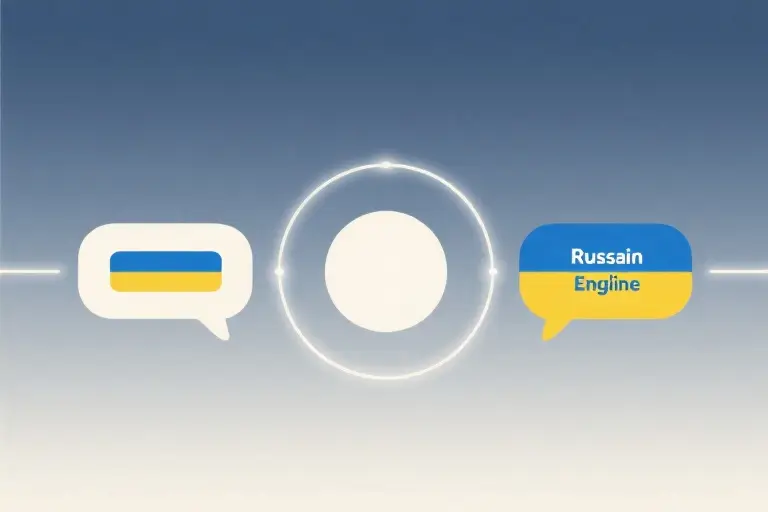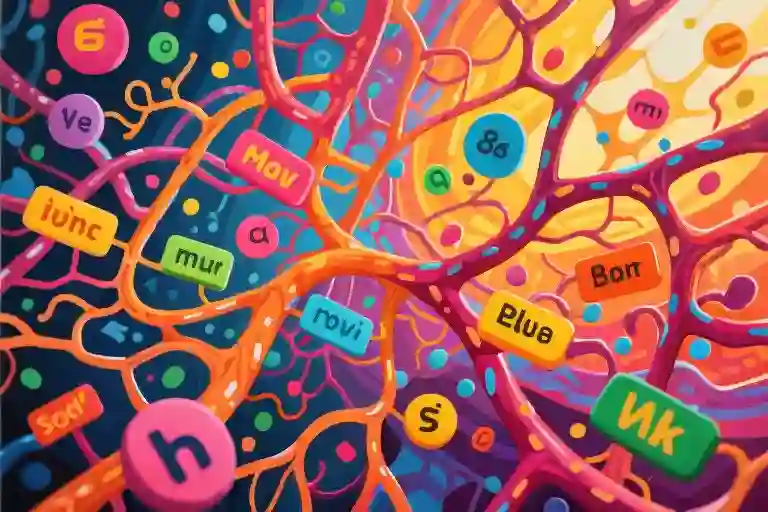Growing up with Russian as my first language felt like breathing—it was just there, woven into bedtime stories, family jokes, and the occasional toddler outburst I didn’t fully understand. So when Ukrainian entered the picture as my mandatory school language, I assumed fluency would come effortlessly. They shared an alphabet, overlapping vocabulary, and cultural roots. How hard could it be?
Turns out, harder than running in stilettos on cobblestone.
I’d open my mouth expecting Ukrainian words to flow, only to freeze mid-sentence as my brain short-circuited between near-identical grammar rules. “Spiv” in Ukrainian meant “soup,” but in Russian, it signaled singing. Prepositions that felt natural in one language clanged like wrong notes in the other. My accent? A dead giveaway that Russian got there first. What should have been a linguistic head start became a minefield of false confidence.
Then came English—a language with baffling spelling, irrational idioms, and zero Slavic training wheels. By all logic, it should’ve been harder. Yet somehow, wrapping my mind around “there/their/they’re” felt less agonizing than Ukrainian’s deceptive familiarity. I wasn’t just learning faster; I was learning differently. The struggle had shifted from “How do I say this?” to “I’ve done this before—where’s the pattern?”
This wasn’t luck or talent. It was my brain finally understanding the meta-skill beneath language acquisition: cognitive transfer. Once you’ve wrestled one language into submission, your mind starts recognizing the shape of the fight. Grammar systems become puzzles you’ve seen variations of. Unfamiliar words trigger context-spotting instincts rather than panic. You develop a tolerance for the discomfort of not knowing—because you’ve survived it before and emerged fluent.
Ukrainian taught me vocabulary. English taught me how to learn.
The Ukrainian Struggle: When Similar Languages Work Against You
Growing up with Russian as my first language felt like breathing. It was effortless, woven into the fabric of my childhood through bedtime stories and the occasional toddler profanity that made adults gasp. So when Ukrainian entered my life as the mandatory school language, I assumed fluency would come naturally. The shared Cyrillic alphabet, overlapping vocabulary, and cultural proximity seemed like a guaranteed shortcut.
Reality delivered a sharp correction. Ukrainian didn’t feel like slipping into comfortable shoes – it was more like breaking in stiff leather boots that constantly pinched. Words that looked familiar carried different meanings, like linguistic traps waiting to snap shut. I’d confidently use a term only to see confusion flicker across my teacher’s face, realizing too late that the Russian word I’d transplanted meant something entirely different in Ukrainian soil.
Grammar became a minefield of hesitation. The cases that flowed instinctively in Russian suddenly required conscious calculation in Ukrainian, turning simple sentences into mental math problems. I developed a nervous habit of pausing mid-phrase, terrified of assigning the wrong gender to a noun or botching verb conjugation. The more I tried to mentally translate from Russian, the more tangled my Ukrainian became.
What made this particularly frustrating was the illusion of accessibility. With languages completely foreign to me like English or German, I expected difficulty. But Ukrainian’s proximity to Russian created false confidence, then magnified every mistake. My brain kept trying to force Ukrainian into Russian-shaped neural pathways, resulting in what linguists call ‘interference’ – when similarities between languages actually hinder learning rather than help.
Classroom moments crystallized this struggle. During a literature presentation, I accidentally used the Russian word for ‘happiness’ instead of the Ukrainian equivalent. The subtle difference in pronunciation drew giggles from classmates, their reactions confirming my growing suspicion: I sounded like someone wearing a poor disguise. My accent, my word choices, even my sentence rhythms betrayed me as a Russian speaker trying to pass as fluent in Ukrainian.
This experience taught me a counterintuitive lesson about language learning: sometimes, familiarity breeds complexity. When two languages share roots but diverge in subtle ways, the brain must work harder to suppress automatic responses from the dominant language. It’s not just about acquiring new knowledge, but actively resisting old patterns – a cognitive tug-of-war that makes second language acquisition fundamentally different from learning your third or fourth.
What began as frustration gradually transformed into fascination. Those Ukrainian classroom struggles became my first conscious encounter with the mechanics of language acquisition, laying groundwork that would later make learning English feel surprisingly manageable. The very difficulties that nearly broke my resolve with Ukrainian – the false cognates, the grammatical interference, the accent anxiety – became reference points my brain would later use to navigate completely different linguistic landscapes.
Cognitive Transfer: Your Brain’s Language Learning Shortcut
The first time I tried speaking Ukrainian after a childhood of Russian, my brain short-circuited. Words that looked familiar meant something entirely different, verb endings followed alien logic, and every sentence felt like assembling furniture with mismatched instructions. Yet years later, when tackling English – a language with no Slavic roots, chaotic spelling, and idioms about feline precipitation – something unexpected happened. It clicked faster.
This paradox reveals a fundamental truth about multilingualism: your third language often feels easier than your second, not because of the language itself, but because your brain has learned how to learn. Cognitive scientists call this phenomenon cognitive transfer – your mind’s ability to repurpose existing knowledge for new challenges.
The Software Update No One Told You About
Imagine your brain as a smartphone. Your first language comes pre-installed (Russian for me). Adding a second language (Ukrainian) requires downloading entirely new system files – you’re building frameworks from scratch. But by the third language (English), your device recognizes the installation pattern. It knows where to allocate memory, how to prioritize updates, and which background processes to run.
This manifests in tangible ways:
- Pattern recognition: Spotting that ‘-tion’ in English often corresponds to ‘-ция’ in Russian
- Context guessing: Understanding ‘heavy rain’ means ‘дождь как из ведра’ without direct translation
- Error tolerance: Saying ‘I go to store yesterday’ without freezing mid-conversation
My Ukrainian struggles taught me something crucial: similarity between languages can be a trap. Russian and Ukrainian shared enough roots to create false confidence, but their differences kept tripping me. English, being distinctly foreign, forced me to develop proper language acquisition muscles – the very muscles that made subsequent languages easier.
The Invisible Toolkit You Already Own
Cognitive transfer isn’t about vocabulary overlap (though that helps between related languages). It’s about meta-skills – the hidden competencies you develop through prior language learning:
- Decoding strategies: That moment when you grasp a Turkish sentence by recognizing verb endings first, just like you learned with German
- Ambiguity tolerance: Not panicking when you only understand 60% of a French podcast, because you survived the same with English
- Memory techniques: Automatically creating vivid associations for Mandarin tones, like you did with Spanish genders
- Grammatical spider-sense: Feeling that ‘der Hund’ sounds right in German while ‘den Hund’ doesn’t, even if you can’t explain the case system
When I started German after English, these tools were already in my belt. I didn’t need to relearn how to memorize vocabulary or parse sentence structure – I could focus on what made German unique. The 80% of language learning that’s transferable between languages had become second nature.
Why Your Third Language Feels Like Coming Home
There’s a quiet confidence that comes with learning additional languages – not from mastery, but from familiarity with the process itself. You begin recognizing universal language patterns:
- Most languages have ways to express past/present/future
- Questions often involve word order changes
- There are usually shortcuts for common phrases
This explains why, during my first Italian lesson, I could predict how to say ‘I would eat’ based on French and Spanish exposure. My brain wasn’t starting from zero; it was cross-referencing existing linguistic databases.
The magic lies in what psychologists call procedural memory – your subconscious knowledge of how to do things. Just as riding a bike transfers to cycling different terrains, language learning skills transfer across languages. You’re not just accumulating words; you’re upgrading your brain’s operating system for multilingualism.
When German Felt Like Coming Home
After surviving the Ukrainian language trenches and navigating English’s chaotic spelling rules, I approached German with cautious optimism. This time, something felt different within the first month. The verb conjugations that had terrified me in Ukrainian now appeared as solvable puzzles rather than impossible mazes.
Take the infamous German verb placement. While my classmates groaned about sending verbs to the end of subordinate clauses, I realized my brain had already built a pattern-detection muscle from wrestling with Ukrainian grammar. Those hours spent untangling Slavic sentence structures had secretly trained me to spot linguistic logic in unexpected places. When our teacher explained dass-clauses, I didn’t memorize rules—I listened for the rhythm, the same way I’d learned to feel when Ukrainian sentences “clicked.”
The Italian Vocabulary Shortcut
Nothing prepared me for the delightful shock of learning Italian after German. Walking through Rome after just three months of study, I could decipher menus, street signs, and casual conversations at about 70% accuracy. This wasn’t genius—it was my brain performing linguistic triangulation using French cognates, Latin roots from scientific Russian terms, and English loanwords.
The magic happened when I stopped translating and started pattern-matching. “Libreria” looked like “library” but meant “bookstore”? My Ukrainian experience had taught me to expect these false friends. “Capire” (to understand) shared roots with French “comprendre” and English “capture”? Suddenly vocabulary acquisition felt less like memorization and more like detective work.
What Changed After the Third Language
With each new language, I noticed three accelerating shifts:
1. The guessing game improved
My brain stopped demanding perfect comprehension. Hearing unknown words in Turkish, I’d latch onto familiar suffixes or context clues rather than freezing up like I had with Ukrainian.
2. Mistakes lost their terror
That paralyzing fear of errors? Gone after English. I’d survived saying “I pick you” instead of “I choose you” in a school play. German’s der/die/das mistakes couldn’t shame me anymore.
3. Learning became modular
Instead of drowning in everything at once (alphabet! pronunciation! grammar!), I could focus. Italian needed pronunciation drills but minimal verb conjugation review. Turkish required script mastery but let me skip gender articles entirely.
This wasn’t about talent—it was about my brain developing a language learning operating system. The first install (Ukrainian) took years. The updates (German, Italian) required progressively less bandwidth because the core framework was already in place.
Making Cognitive Transfer Work For You
By the time you reach your third language, something remarkable happens in your brain – it stops treating each new language as an insurmountable mountain and starts seeing them as variations of the same puzzle. This shift doesn’t happen by accident. Here’s how to intentionally harness cognitive transfer to accelerate your language learning journey.
Reuse What Already Works
That podcast habit that helped you master English pronunciation? Apply it to Spanish. The flashcard system that drilled Ukrainian vocabulary into your long-term memory? Repurpose it for Turkish. Your brain has already developed effective learning pathways – the content changes, but the neural infrastructure remains valuable. I discovered this when using the same notebook format that worked for English to tackle German, simply substituting vocabulary lists with verb conjugations.
Skip the Obvious
If you can already read Cyrillic from studying Russian, don’t waste hours ‘learning’ the Ukrainian alphabet. When approaching Italian after French, focus on the subtle grammatical differences rather than re-studying Romance language basics. This selective approach allowed me to progress through German cases faster by building on my understanding of Slavic grammar structures rather than starting from zero.
Embrace the Awkward Phase
Remember those cringe-worthy early attempts at your second language? The third time around, you’ll recognize this phase as temporary. I stopped panicking when my initial German sentences sounded like English with wrong words – I knew from experience this would pass. Give yourself permission to speak poorly at first, trusting that your brain will self-correct through exposure.
Patterns Over Rules
With each new language, I relied less on memorizing grammar tables and more on noticing natural patterns. After struggling through Ukrainian verb aspects, I could intuitively grasp similar concepts in other Slavic languages. When encountering Turkish’s agglutinative structure, I looked for the underlying logic rather than trying to memorize every suffix combination.
Selective Attention
Not everything transfers perfectly. Focus energy on elements that don’t carry over – for me, this meant drilling German articles (nonexistent in my native Russian) while quickly assimilating cognates. Maintain a ‘transfer gap’ list to identify where your previous experience might mislead you, like false friends between Spanish and Italian.
Cognitive transfer isn’t about cutting corners – it’s about working smarter by leveraging your hard-earned language learning wisdom. Your third language isn’t easier; you’ve simply become more skilled at learning languages. That progress compounds with each new language you add to your repertoire.
The Limits of Cognitive Transfer: What Still Needs Fresh Learning
Cognitive transfer gives language learners a powerful head start, but it’s not a universal pass. Some elements stubbornly resist cross-linguistic shortcuts. Pronunciation often remains the most persistent rebel. When I began learning German after English, my mouth kept defaulting to English vowel sounds. The German “ü” came out as a strained hybrid between “ee” and “oo,” like a teakettle whistling with an identity crisis. No amount of prior language experience could reprogram my tongue’s muscle memory overnight.
Cultural norms present another non-transferable challenge. During my first Turkish conversation, I enthusiastically used the informal “sen” with everyone – only to later discover I’d been unintentionally rude to elders and strangers. My Russian and English backgrounds offered zero preparation for this hierarchy of address forms. Such nuances require conscious study, like learning the social choreography of an unfamiliar dance.
False cognates between seemingly similar languages create particularly treacherous pitfalls. Spanish “embarazada” (pregnant) had nothing to do with embarrassment, as one mortifying mix-up taught me. These deceptive word twins appear frequently in related languages, often masquerading as helpful bridges when they’re actually linguistic traps waiting to spring.
Grammatical structures sometimes defy expectations too. Turkish’s verb-final sentence structure made my Russian-trained brain stutter constantly. I’d mentally construct sentences like nesting dolls only to realize the main verb was missing from its expected position. This wasn’t a matter of vocabulary or conjugation – my very framework for assembling thoughts needed recalibration.
The most surprising limitation emerged with tonal languages. When dabbling in Mandarin, my previous language experience provided no advantage for distinguishing “mā” from “mà.” Pitch variation simply hadn’t been part of my linguistic toolkit. This revealed cognitive transfer’s domain-specific nature – my hard-earned skills from European languages didn’t automatically generalize to entirely different language families.
These boundaries don’t diminish cognitive transfer’s value; they simply map its territory. Recognizing where transfer ends allows learners to allocate effort strategically. Now when approaching a new language, I divide challenges into three categories: what I can adapt from previous knowledge, what needs moderate adjustment, and what requires starting from absolute scratch. This triage system saves countless hours while preventing overconfidence in misleading similarities.
Language learning ultimately combines cognitive transfer with fresh neural wiring. The magic happens when we honor both – letting existing skills accelerate our progress while remaining open to completely new ways of thinking, sounding, and communicating. This balanced approach transforms each new language from an intimidating unknown into an exciting expansion of what our brains can do.
The Language Learning Upgrade: Your Brain’s Hidden Superpower
Language learning isn’t about starting from zero each time. It’s more like upgrading your brain’s operating system—each new language installs fresh capabilities while building on existing frameworks. That moment when Italian verbs suddenly ‘click’ without memorization charts, or when you catch yourself thinking in German without conscious effort? That’s not magic. That’s cognitive transfer in action.
We often approach new languages with unnecessary reverence, forgetting we’ve already survived the hardest part: the first leap into bilingualism. The third language isn’t easier because the grammar is simpler (Turkish’s agglutinative verbs prove otherwise) or because the vocabulary is familiar (looking at you, Japanese loanwords). It’s easier because you’ve fundamentally changed as a learner.
Your brain now recognizes language acquisition patterns like a chef identifies ingredients—you can taste when a sentence needs the salt of conjugation or the spice of prepositional phrases. This instinct develops gradually, often unnoticed, until one day you’re absorbing a new language’s rhythm like background music rather than decoding it like Morse code.
Your Multilingual Future Starts Now
That dormant language you’ve been meaning to learn? The one that keeps getting postponed because ‘it’s too different’ from what you already know? Your brain is more prepared than you realize. Those Spanish flashcards from 2012 created neural pathways that will serve you when tackling Portuguese. Those painful Mandarin tones trained your ear for Vietnamese’s pitch variations. Nothing is wasted.
Start small but start today. Dust off that old language app and notice how differently you approach the exercises now. Revisit a previously intimidating language with your hard-won learner’s intuition. The rules haven’t changed, but you have—and that makes all the difference.
Languages stop being separate mountains to climb and become interconnected terrain to explore. The confidence you’ve earned through previous struggles is your most valuable learning tool. Use it generously.





